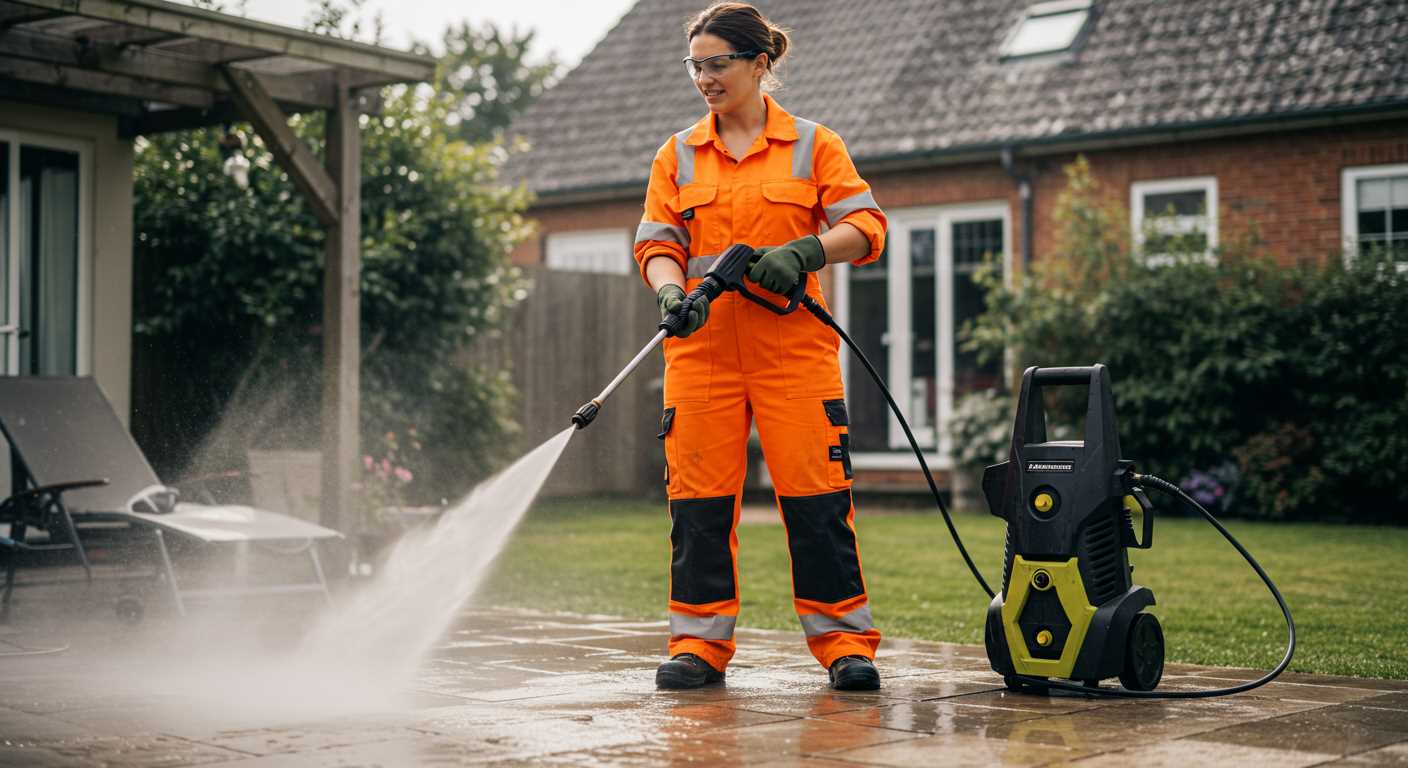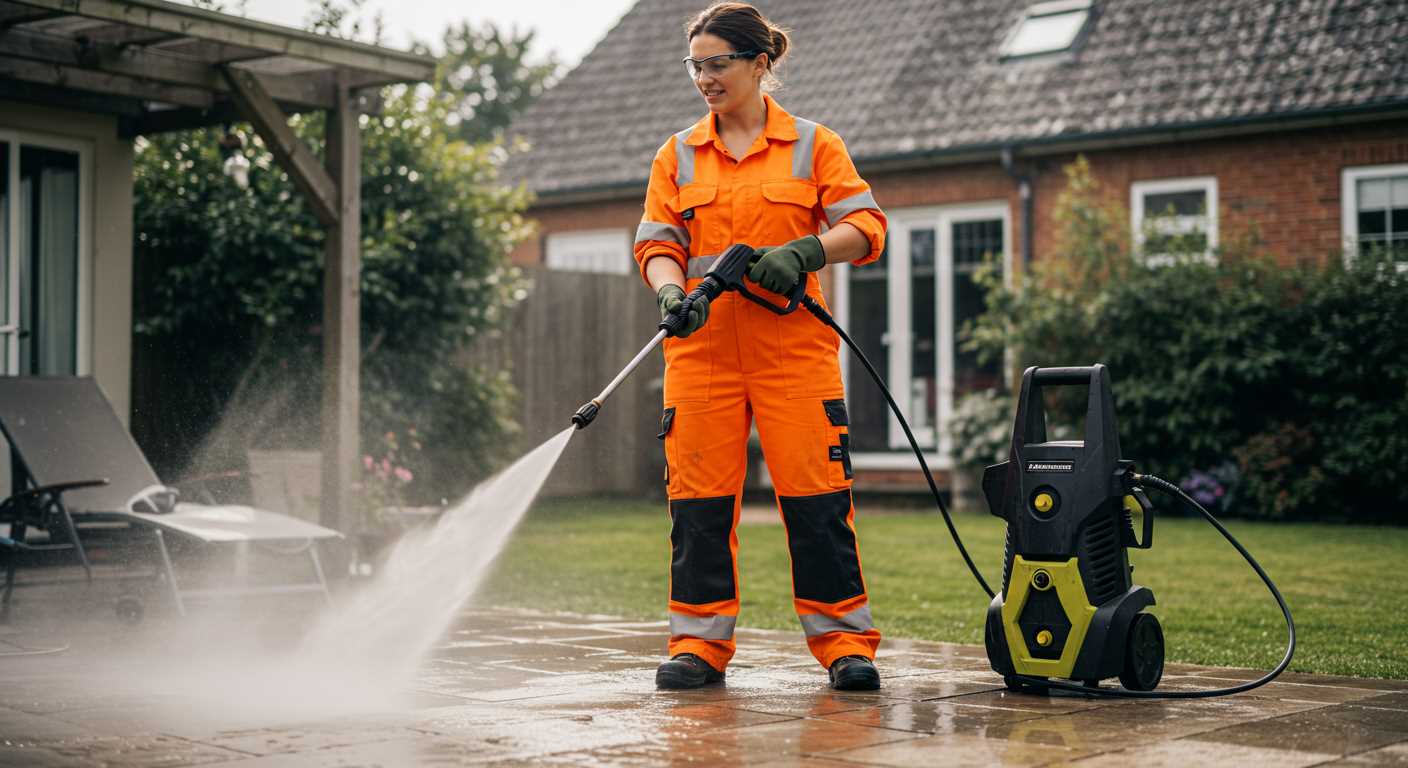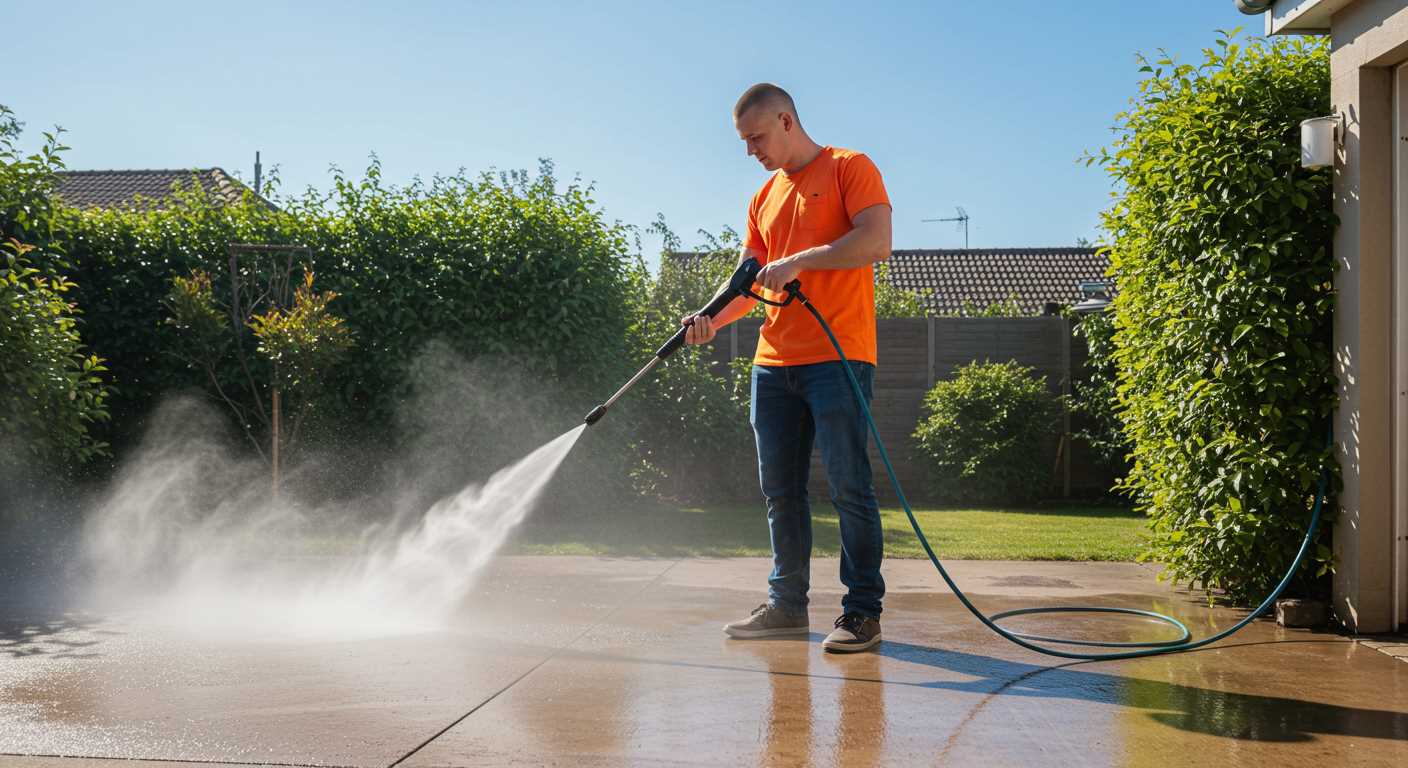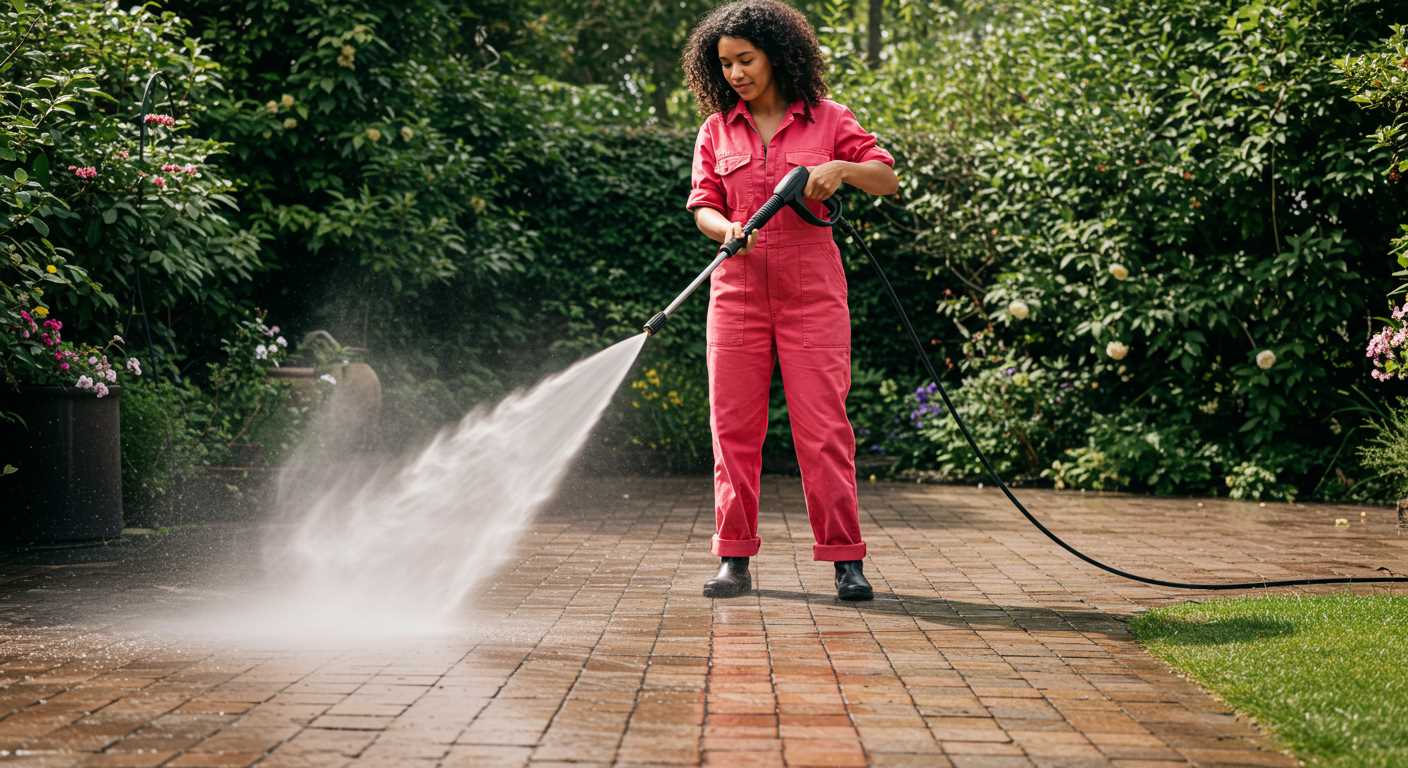




If you’re looking to restore the appearance of your concrete surfaces, a machine with a rating between 3000 and 4000 pounds per square inch (psi) will yield the best results. I often recommend starting at the lower end of this scale for general grime and mildew removal, particularly if the surface hasn’t been cleaned in a while. A machine at 3000 psi is usually sufficient for most residential tasks.
During my years in the industry, I frequently encountered stubborn stains from oil or rust that required a more robust approach. In such cases, a unit rated around 4000 psi proves invaluable. This higher pressure can tackle even the toughest debris, ensuring a thorough clean without damaging the concrete. However, it’s crucial to maintain a safe distance when using these more powerful models to avoid etching the surface.
Another aspect to consider is the nozzle type. A 15-degree nozzle often works best for tough stains, while a 25-degree nozzle is ideal for broader cleaning tasks. I’ve found that switching nozzles according to the job can make a significant difference in both efficiency and results.
Lastly, don’t forget about the cleaning solution. Using a suitable detergent can enhance the effectiveness of your high-pressure equipment, allowing you to achieve that pristine finish on your concrete surfaces. Combining the right pressure, nozzle, and cleaning agent can transform your outdoor areas into inviting spaces.
Recommended Pressure Levels for Concrete Surfaces
For optimal results on concrete surfaces, I suggest a unit delivering between 3000 and 4000 PSI. This range effectively tackles tough stains, grime, and built-up debris without damaging the underlying material.
During my years in the cleaning equipment industry, I encountered various scenarios involving different concrete conditions. Here are some insights based on my experiences:
- Stains and Oil Marks: For stubborn oil stains, a model with 3500 PSI worked wonders. The higher pressure penetrates the stain, lifting it more efficiently.
- Regular Maintenance: If you’re simply maintaining your driveway or patio, a 3000 PSI unit suffices. It cleans effectively while being gentle enough to avoid wear over time.
- Heavy-Duty Jobs: For commercial settings or heavily soiled areas, leaning towards a 4000 PSI machine can save time and effort. I’ve seen significant improvements in cleaning times with this power level.
When choosing a nozzle, opt for a 15-degree or 25-degree tip. These angles provide a balance of force and spread, ensuring thorough cleaning without risking damage. Always keep the nozzle at least 12 inches away from the surface to prevent pitting.
It’s also wise to consider the flow rate, measured in gallons per minute (GPM). A flow rate of 2.5 to 4 GPM complements higher pressure, enhancing the cleaning efficacy. For instance, combining 3500 PSI with 3 GPM delivers impressive results, cutting through dirt and stains efficiently.
Lastly, don’t overlook the importance of cleaning solutions. In many cases, pairing the right pressure with a quality detergent can elevate the effectiveness of your efforts. Always follow the manufacturer’s recommendations for compatibility and application.
Understanding PSI Ratings for Concrete Cleaning
For optimal results on concrete surfaces, aim for machines delivering between 3000 to 4000 units of pressure. This range effectively removes stubborn stains like oil, grime, and mildew without damaging the surface. A personal experience comes to mind: I once tackled a driveway caked with years of neglect. Using a unit rated at 3500, I was amazed at how effortlessly the dirt lifted away, revealing the original colour of the concrete.
Key Factors Influencing PSI Selection
While pressure is crucial, the nozzle type and cleaning solution also play significant roles. A 25-degree nozzle is often ideal for most concrete tasks, providing a balance between power and coverage. I recall a project where I experimented with different angles; the 25-degree made it easier to clean without leaving behind stripes or damage.
| Pressure (PSI) | Application | Nozzle Recommendation |
|---|---|---|
| 2000-2500 | Light stains, dirt | 40-degree |
| 2500-3000 | Moderate grime, mildew | 25-degree |
| 3000-4000 | Heavy stains, oil | 15-degree |
Additional Tips for Effective Results
In my experience, pre-treating surfaces with a suitable cleaning agent enhances outcomes significantly. Allowing it to sit for a few minutes before rinsing can break down tough stains more effectively. I once underestimated this step and found that the results were far less satisfying than when I properly prepped the area. Always remember, matching the pressure with the right technique is key to achieving that clean and fresh look for your concrete surfaces.
Optimal PSI Levels for Different Concrete Surfaces
For most general concrete surfaces, a range of 2,500 to 3,000 units is ideal. This level effectively removes dirt, grime, and stains without risking damage to the surface. I recall a time when I tackled a driveway covered in years of oil stains. Using a unit set to 2,800 units, the results were outstanding, restoring the surface’s appearance without any chips or cracks.
When addressing more delicate or aged concrete, such as patios or walkways, reducing the pressure to around 1,500 to 2,000 units can prevent wear while still achieving satisfactory results. I once had a client who was hesitant to clean their old patio due to fears of damage. By adjusting the settings to 1,800 units, we managed to refresh its look without compromising its integrity.
For commercial-grade surfaces or heavily soiled areas, like parking lots, increasing to 3,500 units or more may be necessary. I remember a project at a local garage where grease and grime were entrenched. A high setting at 3,600 units, combined with the right nozzle, cut through the filth and left the concrete looking like new.
Always consider the age and condition of the surface before selecting the optimal settings. Testing a small, inconspicuous area first can save a lot of hassle down the line. If you’re unsure about connecting your equipment, check out this guide on connecting a pressure washer to the water tap made easy.
Choosing the Right Nozzle for Concrete Cleaning
For optimal results, I recommend starting with a 0-degree or 15-degree nozzle when tackling tough stains on concrete surfaces. The narrow jet of these nozzles delivers concentrated force, effectively dislodging grime and dirt embedded in the pores of the material. In my experience, the 0-degree nozzle is particularly useful for stubborn marks, such as oil or grease, while the 15-degree option provides a slightly wider spray, making it versatile for general cleansing tasks.
Understanding Nozzle Types
Each nozzle type serves a unique purpose. The 25-degree and 40-degree nozzles, with their broader spray patterns, are best reserved for less intensive jobs, such as rinsing off loose debris or light stains. While they may seem tempting for quick work, they often fail to penetrate deeply into tougher spots. I once tried using a wider nozzle on a heavily stained driveway, and it took far longer to achieve satisfactory results compared to when I switched to a narrower option.
Additional Tips for Nozzle Selection
Always ensure that the nozzle is compatible with the equipment you’re operating. Mismatched nozzles can lead to inefficiency and potential damage. It’s wise to experiment with different angles and distances from the surface to find the sweet spot that maximises cleaning power without risking damage to the concrete. I recall a project where I got too close with a 0-degree nozzle and ended up etching the surface. A steady hand and a careful approach go a long way in achieving a clean finish without compromising the integrity of the concrete.
Common Stains and Their Required PSI Settings
For stubborn oil stains, aim for a level of around 3000 to 3500 units. This intensity effectively breaks down grease without damaging the surface. Once, I tackled a particularly tough oil spill in a garage, and the higher setting made quick work of it, revealing the clean concrete underneath.
Rust and Mineral Deposits
Rust requires a more gentle touch, typically between 1500 to 2500 units. I’ve found that too much force can etch the concrete, creating more problems than it solves. Using a lower setting allows for safe removal while preserving the integrity of the surface. For mineral deposits, stick to the same range, as both require patience and the right technique.
General Dirt and Grime
For general dirt and grime, a setting of 2000 to 3000 units usually suffices. I remember cleaning a patio that hadn’t seen a good scrub in years; this range helped lift years of built-up grime easily. Remember to adjust your nozzle accordingly for the best results, as the right attachment can make all the difference.
If you’re curious about other cleaning techniques, check out this guide on how to can corn without pressure cooker. It’s always handy to have versatile skills at your disposal.
Safety Considerations When Using a Pressure Washer on Concrete
Always wear appropriate personal protective equipment (PPE), including safety goggles, gloves, and sturdy footwear. High-pressure streams can cause severe injuries if they come into contact with skin or eyes. I recall a colleague who neglected this precaution and ended up with a nasty cut from a stone that was dislodged during a job.
Maintain a safe distance while operating the machine. Keeping at least two feet away from the surface protects against debris and allows for better control. I remember a time when I got too close, and the recoil from the spray nearly knocked me off my feet. It’s a lesson learned the hard way.
Inspect your unit thoroughly before starting. Check hoses and connections for wear or damage. A burst hose can lead to unexpected accidents. I’ve seen hoses rupture during operation, causing chaos and endangering those nearby.
Be aware of your surroundings. Ensure no one is within the spray zone, especially children or pets. When I was working on a residential drive, I made it a point to inform the homeowners to keep their kids away. It’s a simple step that can prevent accidents.
Always direct the nozzle away from yourself and others. I once witnessed a mishap where a friend accidentally aimed towards his foot while adjusting the angle, leading to a painful abrasion. That was a reminder for all of us about the importance of control.
Consider the surface condition. If the concrete is uneven or has cracks, be cautious, as the high force can worsen these issues. I’ve encountered situations where rushing through a job led to more damage than good, resulting in costly repairs for clients.
Finally, be mindful of slip hazards. Water can create slippery surfaces, especially if soap or detergents are involved. I always keep a broom handy to clear water from walkways after a job. It’s a small effort that can significantly enhance safety.
Maintenance Tips for Equipment Used on Concrete
Regularly inspect the components to ensure everything is functioning correctly. Pay attention to hoses and connections; even minor leaks can affect performance. Replace any damaged parts promptly to prevent more significant issues down the line.
Keep the nozzle clean. A clogged nozzle can alter the spray pattern and reduce effectiveness. After each session, rinse the nozzle with water to remove any debris. If you notice a significant change in performance, consider soaking it in a vinegar solution to dissolve any built-up grime.
Check the oil levels in the motor regularly. A well-lubricated engine runs smoother and lasts longer. If the oil appears dirty or discoloured, change it before your next session to keep everything running optimally.
Store the equipment in a dry, protected area when not in use. Exposure to moisture can lead to rust and corrosion, particularly on metal parts. If you must store it outside, invest in a quality cover to shield it from the elements.
Winter can be tough on machinery, particularly if left outside. If you live in a colder climate, consider winterising the engine by running a stabiliser through it. This will help prevent potential damage from freezing temperatures.
Perform a thorough clean of the equipment after each use. Remove any dirt or residue that may have accumulated during the task. This simple step will keep components in good shape and ready for your next project.
Lastly, keep an eye on the detergent you use. Not all formulations are suitable for every task. Using the wrong type can lead to build-up within the system, potentially causing clogs or damage. Always opt for a cleaner recommended for your specific machinery.






.jpg)


